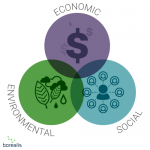Let’s face it, change management is one of the biggest threats to success while implementing new business software. Top risks of poor change management include: resistance to change, lack of resources, costs (delays, budget overruns), and failure to deliver expected results. To me, the number one risk is missing from the above. Why? Cause we’re leaving the process out of the equation. Beyond resistance to change, how can an organization guarantee that its staff will use a product? This brings me to the first question I always ask managers when they tell me they don’t see value in documenting their communication strategy and engagement activities:
How do you measure your social team’s work? Can you tell me who’s doing what, when and what are the outcomes? What metrics are you using?
That’s typically the moment when I get what I like to call “the blank stare.” If you can’t measure engagement, aren’t you wasting a whole lot of time, energy and (probably) money trying to achieve something with no tangible results to support activities and decision-making? To reinforce my argument, I then make a parallel between stakeholder management software and financial systems by asking the following question:
Does your organization use a financial system with a well-implemented process to manage finances, from purchases, to invoicing, and including payroll?
And this is when the “Duh moment” hits, when it all suddenly makes sense. Of course, they do. Everyone does. There isn’t a single well-run business that doesn’t have a rigorous, controlled and efficient financial system to manage its cash flow. So why doesn’t the same apply for your organization’s communications? Are they not as important to your operations, reputation and business strategy as finances? The answer is yes, they are just as important. But many organizations, still to this day, fail to see the value in documenting and analyzing this information because they simply don’t understand that they have a triple bottom line that does way beyond economics:
Understanding the value of documenting stakeholder engagement activities
Many are tempted to use their existing business tools to document their communications and engagements, which usually doesn’t prove the added-value it brings to a business, on the opposite. If you’re not documenting information properly, your analysis will be tainted and it will be impossible for you to build a relevant strategy. For instance, CRMs, as valuable as they are, are no match when it comes to managing stakeholder engagement activities. That being said, they’re a great tool to use in parallel to manage (and document!) the sales process. Integrations between stakeholder engagement software and CRMs can bring great benefits to an organization. But that’s an entire subject on its own.
Social interactions are quite abstract. Documenting them means you’ll need to focus on tangible, precise metrics to be able to then analyze them properly. Here are a few examples of relevant ways to measure social issues, communications and overall engagement:
- What was the general sentiment of your last meeting with stakeholders? Positive, neutral, negative.
- What is the frequency of your interactions with stakeholders? Daily, weekly, monthly, quarterly.
- Who is initiating the interactions: your organization, stakeholders, authorities (like governments)?
- Were your latest interactions in a specific geographical area? Why so?
Sure, having the proper tool to document, track and report on such questions provides a strong basis to support your communications and engagement strategy. But let’s keep it real: as valuable as it is, the tool will not do the work for you. It’s a piece of the puzzle.
It all begins with the process
You’re contemplating (or already completed) the purchase of stakeholder engagement software? That’s great, it’s the first step towards building a better engagement strategy. Now, all your focus should be on the process. So, where should you start? You’ll have to begin by reviewing your internal practices, from objectives to staff roles.
What are the current performance goals of your team? I bet they do not include anything that comes even close to documenting their communications, or using software to build your organization’s institutional memory. This means they’ll need to be updated and aligned with your new tool.
As a CEO, I always find myself managing staff, whether it’s on a weekly or monthly basis. I like to use dashboards to review issues, trends, and business opportunities. But for me to be able to grasp the whole picture, my team must enter all that information in our system. Which brings me back to the previous section: everyone must see the value of your stakeholder engagement tool. Because when people don’t, that’s when we notice inconsistencies in usage. And it’s always easy to point fingers at who is to blame when a new tool fails to be adopted by a team.
I’ve always been a field operations guy, and rather than pointing fingers, I like to take a second to take a look in the mirror. How can I expect my team to be using a tool if I don’t even use it myself? That’s why every member of my team (including myself) knows just how valuable our stakeholder engagement application is to run business smoothly (In our case, we use the product we develop: Boréalis. We’re able to improve the product from our own experience as users who face the same pains our customers do.).
Here’s the golden rule to implementing stakeholder engagement systems:
If you want to guarantee that your team will use it, management must also use it. It’s that simple.
The key to success: everyone must put their shoulder to the wheel
Of course, you’ll have to deal with resistance to change at first. People are reluctant to change their working habits. Even if it’s just a little change. And most times, they’re under the impression that this will burden and slow down their activities, when, in the end, it’s the contrary. The only thing that your team will have to add to its ongoing engagement activities (and it can either be added to the tasks of a current team member or become a role in itself depending on the size of your team) is a data quality assessment. Because let’s face it, if everyone is aimlessly dumping information in a database without ensuring consistency and accuracy, you won’t be getting much more than a full server that offers little to no strategic insights. That’s why you’ll need someone in charge of ensuring that this is done properly. That’s also why, as a manager, you’ll have to lead this change by using the system.
The best way to encourage adoption? Make the documenting process part of tasks. Unless you want to find yourself in the same spot in 6 to 12 months, with no idea of what has been implemented, who received what information, who is happy with your project, or even worse, who isn’t! When unable to follow and document a communications plan, it’s impossible to expect and ask for tangible results. Documenting these activities, in addition to building your organization’s institutional memory, will allow a rigorous tracking of issues and risks, all thanks to internal processes. And this goes way beyond the “I’ll handle my engagement strategy on Post-it notes and spreadsheets.”
Raise in regulatory requirements: when documenting interactions is no longer just a nice-to-have
Over the past few years, many corporations found themselves face to face with the new challenge of reporting on their communications to governmental authorities. And this trend is on the raise as more and more regulations pop up to guide how companies should manage their accountability and corporate citizenship. For instance, energy companies located in the province of Alberta, in Canada, must report to the Alberta Energy Regulator, while organizations in the utilities industry report to the Alberta Utilities Commission.
Final words of wisdom: if you’re not using the system, you can’t expect staff to see the value in it. I therefore encourage all managers to walk the talk. You’ll instantly notice a difference in the attitude of your team!






